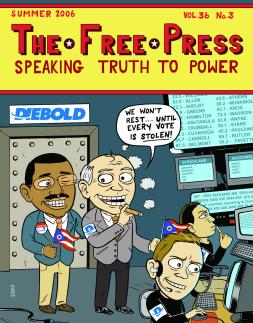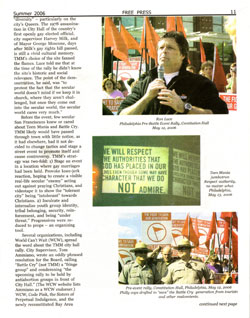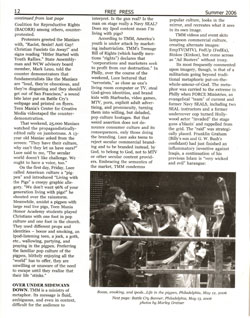
I began researching Teen Mania Ministries (TMM) in 1999 and have since attended five events. I missed the controversial March 2006 Battle Cry initiative in San Francisco, the protest of which received widespread media attention. But I have examined broadcast videotapes of this year’s national events there and in Detroit, and footage from the San Francisco demonstration. In May, I attended TMM’s national Philadelphia event at Wachovia Spectrum, and a pre-event demonstration and protest. I am one of the first reporters to attend multiple events, including the largest-ever event – 1999 Day One at the Silver dome in Pontiac, Michigan – and to write about it. Attending the events personally creates a “reality” different from the reality I get when viewing videotapes. In-person events, though tightly controlled, instill chaos, urgency, claustrophobia, and, strangely, boredom. The videos (even after attending the events) create feelings of manipulation, ordered spontaneity, and compressed time. No matter how I observe TMM, one reference remains: the 1960s’ TV show Outer Limits. Sterility, control, disembodiment, and paranoia. A known us versus an unknowable them.
SAN FRANCISCO. In March, under the banner of the “Battle Cry For A Generation” initiative (or campaign), Texas-based Teen Mania Ministries held a “national” event in San Francisco. For nearly 20 years, TMM has flown under the radar of the secular press and general public, despite endorsement and support from big name evangelical organizations, church leaders, and Republican politicians, including Bush 1 and 2. At its “Acquire the Fire” regional and national events, which have attracted as many as 70,000 participants, teens get to rock with “safe” Christian performers, and listen to hours-long sermons from Ron Luce and other evangelical speakers and political luminaries. The cast has included professional wrestlers, former Taliban hostages, grieving Columbine family members, NFL star Reggie White, and Gerald Ford. Still, TMM has caused barely a ripple in the secular media.
This changed when self-described Teen Maniacs, waving red flags, and some clenching their fists, threw a so-called “reverse rebellion” at City Hall against what Luce called “virtue terrorism” and “virtue terrorists”: purveyors of popular culture, media, and advertising. Seasoned TMM observers understood that Luce’s focus on City Hall, which he described to youth pastors as a place where “several months ago gay marriages were celebrated for the entire world to see,” would be interpreted by the city’s “progressive community” as an attack on “diversity” — particularly on the city’s Queers. The 1978 assassination in City Hall of the country’s first openly gay elected official, city supervisor Harvey Milk, and of Mayor George Moscone, days after Milk’s gay rights bill passed, is still a vivid cultural memory. TMM’s choice of the site fanned the flames. Luce told me that at the time of the rally he didn’t know the site’s historic and social relevance. The point of the demonstration, he said, was “to protest the fact that the secular world doesn’t mind if we keep it in church, where they aren’t challenged, but once they come out into the secular world, the secular world cares very much.”
Before the event, few secular San Franciscans knew or cared about Teen Mania and Battle Cry. TMM likely would have passed through town with little notice, as it had elsewhere, had it not decided to change tactics and stage a street event to promote itself and cause controversy. TMM’s strategy was two-fold: 1) Stage an event in a location where gay marriages had been held. Provoke knee-jerk reaction, hoping to create a visible real-life secular “enemy” acting out against praying Christians, and videotape it to show the “tolerant city” being “intolerant” towards Christians. 2) Inculcate and internalize youth group identity, tribal belonging, security, reinforcement, and being “under threat.” Progressives were the props — an organizing tool.
Several organizations, including World Can’t Wait (WCW), spread the word about the TMM city hall rally. City Supervisor, Tom Ammiano, wrote an oddly phrased resolution for the Board, calling “Battle Cry” (not TMM) a “fringe group” and condemning “the upcoming rally to be held by antiabortion groups in front of City Hall.” (The WCW website lists Ammiano as a WCW endorser.) WCW, Code Pink, the Sisters of Perpetual Indulgence, and the newly reconstituted Bay Area Coalition for Reproductive Rights (BACORR) counter-protested.
Protesters greeted the Maniacs with, “Racist, “Sexist! Anti Gay! Christian Fascists Go Away!” and signs reading “Hitler Started with Youth Rallies.” State Assemblyman and WCW advisory board member, Mark Leno, told the counter demonstrators that fundamentalists like the Maniacs are “loud, they’re obnoxious, and they’re disgusting and they should get out of San Francisco,” a sound byte put on Battle Cry’s webpage and printed on flyers. Teen Mania’s Center for Creative Media videotaped the counter-demonstration.
That weekend, 25,000 Maniacs watched the propagandistically-edited rally on jumbotrons. A 13-year old Maniac asked from the screen: “They have their culture, why can’t they let us have ours?” Luce to me, “The secular world doesn’t like challenge. We ought to have a voice, too.”
On the first day, Friday, Luce called American culture a “pigpen” and introduced “Living with the Pigs,” a graphic creepy allegory. ‘We don’t want 96% of your generation living with pigs!” he shouted over the rainstorm. Meanwhile, amidst a pigpen with large real live pigs, Teen Mania Honor Academy students played Christians with one foot in pop culture and one foot in the church. They used different props and identities — booze, smoking, an iPod listening teen, a jock, a goth, etc., wallowing, partying, and praying in the pigpen. Preferring the familiar pop culture of the pigpen, blithely enjoying all the “world “ has to offer, they are unwilling or unaware of the need to escape until they realize that their life “stinks.”
OVER UNDER SIDEWAYS DOWN. TMM is a ministry of metaphor. Its message is fluid, ambiguous, and even in context, difficult for the audience to interpret. Is the gun real? Is the man on stage really a Navy SEAL? Does my iPod content mean I’m living with pigs?
According to TMM, America’s youth is under attack by marketing industrialists. TMM’s Teenage Bill of Rights (which hardly mentions “rights”) declares that “corporations and marketers seek to profit from our destruction.” In Philly, over the course of the weekend, Luce lectured that “terrorists,” as close as one’s living room computer or TV, steal God-given identities, and brand kids with Starbucks, video games, MTV, porn, explicit adult advertising, and promiscuity, turning them into willing, but deluded, pop culture hostages. But that weird assertion does not denounce consumer culture and its consequences, only those doing the branding. Luce asks teens to reject secular commercial branding and to be branded instead, by God, to belong to God, not to MTV or other secular content providers. Embracing the semantics of the market, TMM condemns popular culture, looks in the mirror, and recreates what it sees in its own image.
TMM videos and event skits lampoon commercial culture, creating alternate images: EmpTV (MTV), FedUp (FedEx), Binkos (Kinkos), but come across as “Ad Busters” without irony.
Its most frequently commented upon imagery, though, is that of a militarism going beyond traditional metaphoric put-on-the-whole-armour-of-God. The metaphor was carried to the extreme in Philly when FORCE Ministries, an evangelical “team” of current and former Navy SEALS, including two SEAL instructors and a fomer undercover cop turned Hollywood actor “invaded” the stage guns a’blazin’ and rappelled from the grid. The “raid” was strategically placed. Franklin Graham (Billy’s son and G. W. Bush’s confidant) had just finished an inflammatory invective against Iraqis, a continuation of his Islam is “very wicked and evil” harangue:
“They hate the name of Jesus Christ and they are warring against every standard that God has ever created, not only are they against Christ but every standard of almighty God. Now those Babylonians, you know, you watch on television today, y'know they're still cuttin' heads off over there, they're still crazy, wild, and it's no difference between these Iraqis today than those Babylonians were thousands of years ago.”
Luce dismisses alarm over TMM’s militarism. “We need to be strong,” he says, “…The militarism says we won’t take a backseat. It’s a way of thinking.”
What happens when metaphor crosses into reality, no one addresses.
THE STORY.The 2006 TMM Battle Cry campaign intentionally provoked public scrutiny. The San Francisco event was described in a range of ways, as a “Christian Lollapalooza” (Time Magazine) for “fresh-faced Christian kids” (Concerned Women for America) “acting within their rights” (Bill O‘Reilly) and a “fringe group” with “an agenda of intolerance,” (San Francisco Board of Supervisors) consisting of “Christian fascists” supported by “religious lunatics” (WCW). Reporters, apparently satisfied with pyro and rock n’ roll, ignored the event’s true content.
The “progressive” press and bloggers were vocal, due partially to agitation by World Can’t Wait's Sunsara Taylor. Taylor, a self-described “former Christian” appears to have transferred her zeal from one enveloping cause to another, banging her Bible with the best of them, modeling herself into an absurd postmodern Bible swinging Communist lecturing 15-year old evangelicals on the “real” meaning of the Bible. She appeared on the “O‘Reilly Factor” the Monday after the protest to “debate” Ron Luce. In May, she showed up in Philadelphia to counter-demonstrate. Thanks to Taylor’s oft reposted retelling of her Philly experiences, on the street and in the TMM Wachovia Spectrum, Teen Mania stories bounced around websites and blogs. A sort of “telephone” game was played among unsourced insta-experts, who two weeks earlier had never heard of TMM, backslapping and quoting each other but not Teen Mania itself. Consequently, Teen Mania was dumbed-down to spectacle, aesthetics, absolutism, and the organizing agendas of others with no discussion of what Teen Mania actually was — and wasn’t.
THE BANNER. The military aspects of TMM are deeply troubling [to the average spectator], but Maniacs are not all Bush’s foot-soldiers. Teen Mania, Battle Cry and its activities cannot be cubby-holed in explicitly partisan terms. TMM espouses “godly values over culture” ultimately to replace secularism with a yet-to-be-defined theonomist or Biblical-inspired society. TMM’s purpose is to grow youth group and church membership. The blueprint for growth is found throughout TMM propaganda, like the new Battle Cry brochure, "Lift the Banner," distributed to the public and available for download.
“This is the purpose of the Battle Cry Campaign — to establish a support structure for the local youth group. It calls for at least 100,000 local churches and 1,000,000 individuals to join the Battle Cry Coalition and commit to the planning, prayer and work required to grow their youth group. It is calling for senior pastors, youth leaders, concerned adults and teenagers to work together in their church to double the size of their youth group each year for the next 5 years.” From “Lift the Banner,” page 7.
Although Luce claims TMM is not political, the Battle Cry initiative, according to its literature, has a specific legislative strategy to “inform lawmakers of the plight of this generation and lobby them to pass legislation that protects our teens from the dangers they face while online and from advertising and other electronic media.” This “protection” seems to extend to anything TMM and Luce find “offensive,” though. No one should think the protection is limited to teens.
TMM’s soft agenda is deceiving. The real agenda appears to run much deeper: Enlisting teenagers into “God’s army,” marketing them a new “god-branded” god-branded identity, and sending them headlong into what Luce has called the “culture war” to transform secular American society. A transformation that will be dual traced, as simple as one-on-one recruitment and as overt as a legislative agenda.
ADDENDA. According to TMM’s public relations firm, the DeMoss Group, several Central Ohio churches sent their youth groups to Detroit and Philadelphia: Vineyard at Tuttle Crossing, Northwest Nazarene, First Alliance Church (all in Columbus); Faith-full Family Church (New Albany); Shekina Christian Center Foursquare Church (Heath), Good Shepherd Church and the Life Church; and most notably, Reform Ohio Patriot Pastor Russell Johnson’s Fairfield Christian Church (Lancaster).
Marley Greiner is a long-time theocracy watcher and Free Press Board member. A longer version of this story with photos appears at http://theoconia.blogspot.com/.
From the Free Press
(Columbus, Ohio), Vol. 36 No. 3, Summer 2006.
Reprinted here by
permission of the author.
Additional
photos and commentary appear on the author's blog, Theoconia.
A PDF with scans of the
article is also available.
Posted 2006-07-25
Updated 2006-07-31















